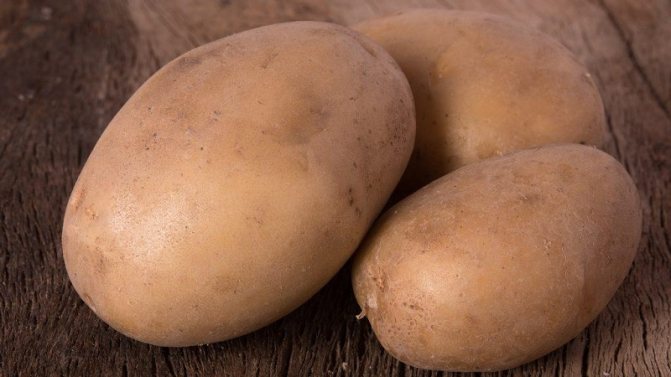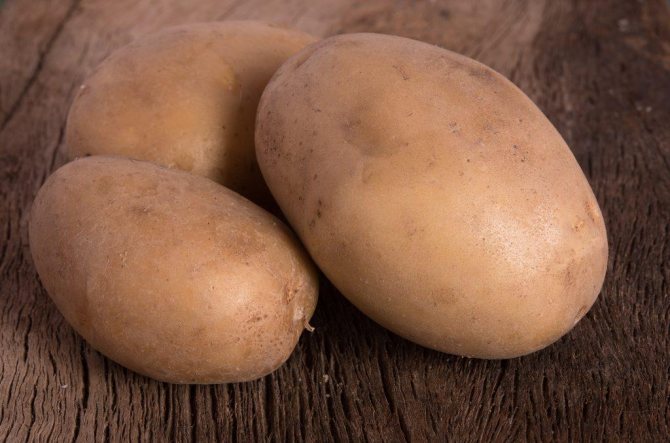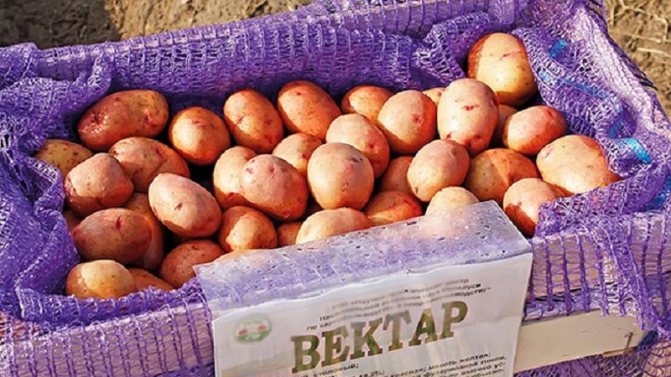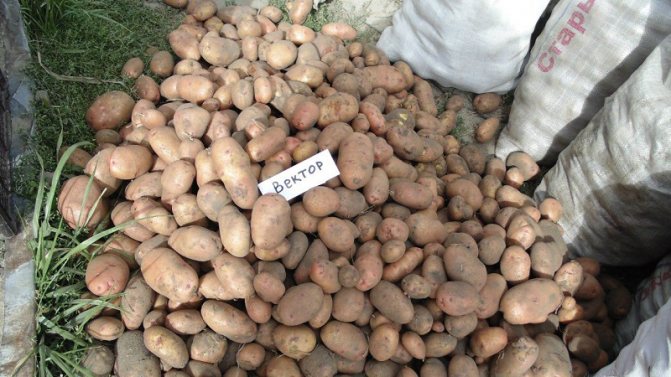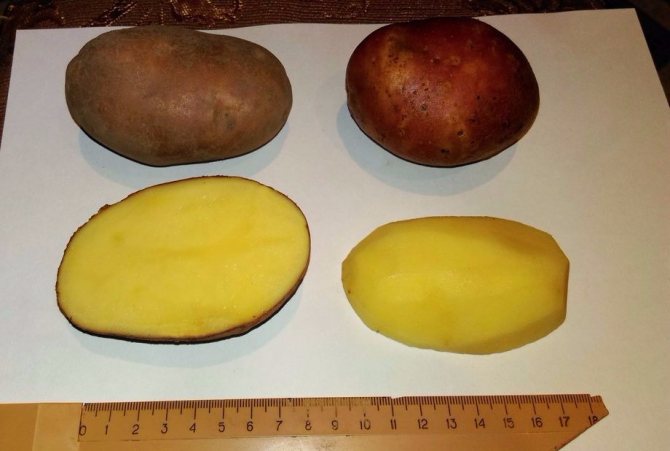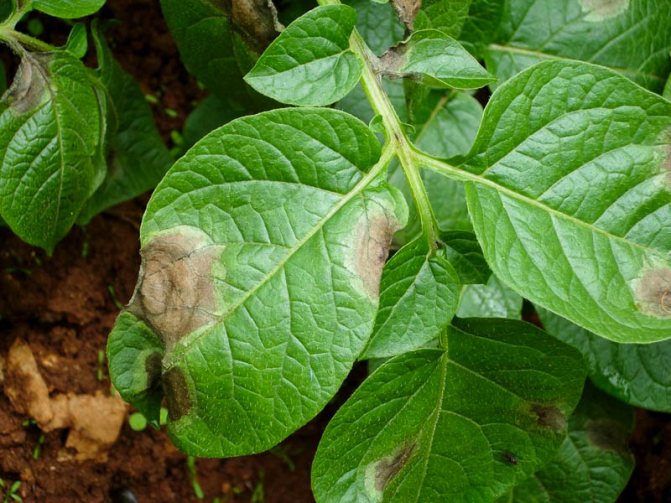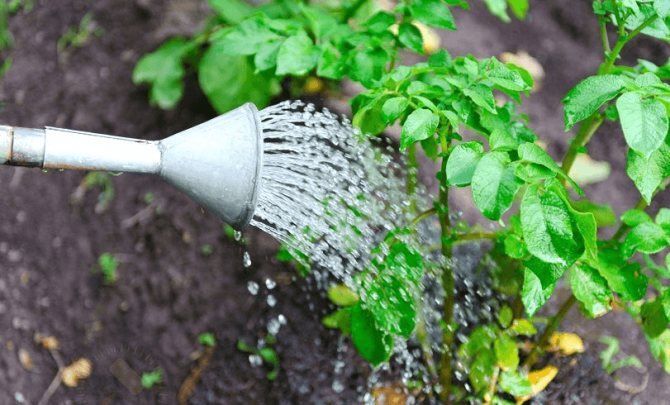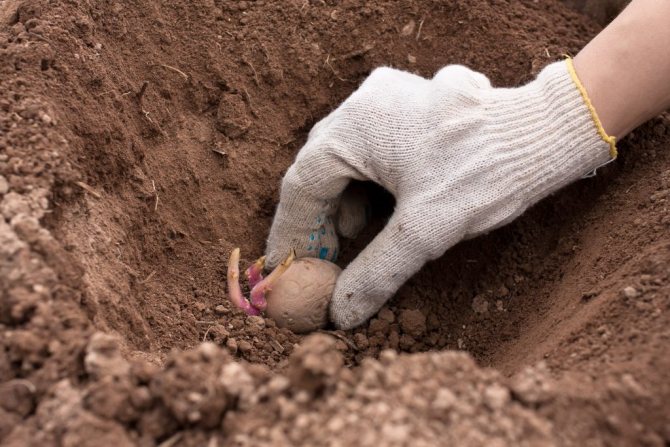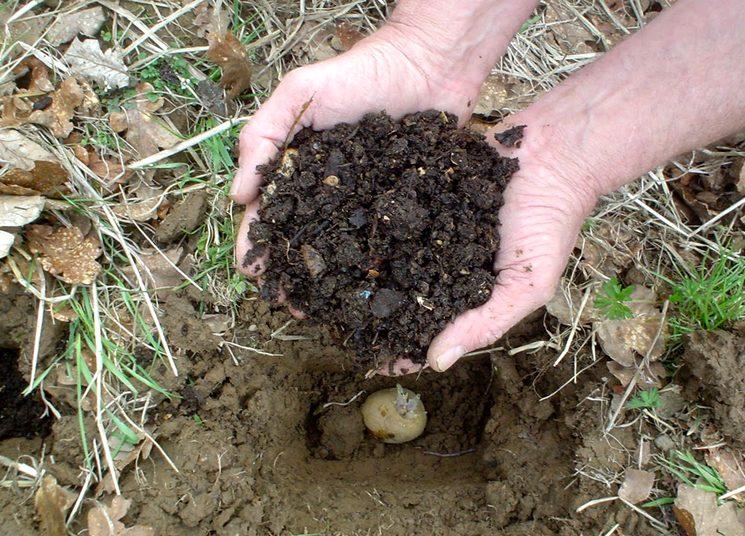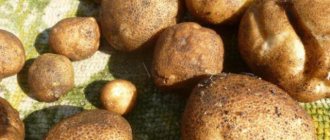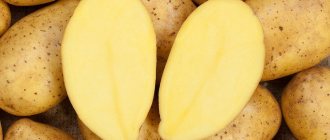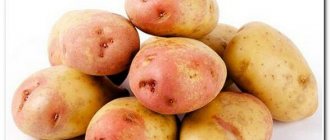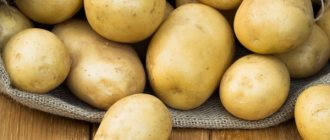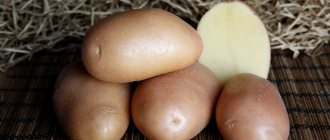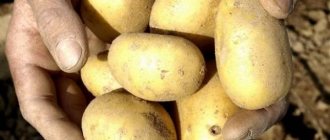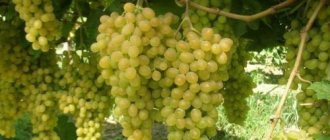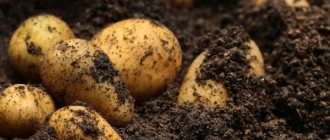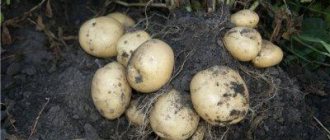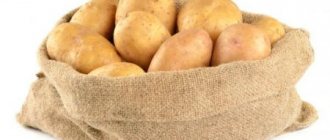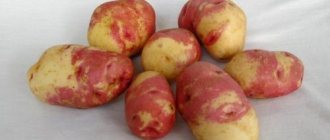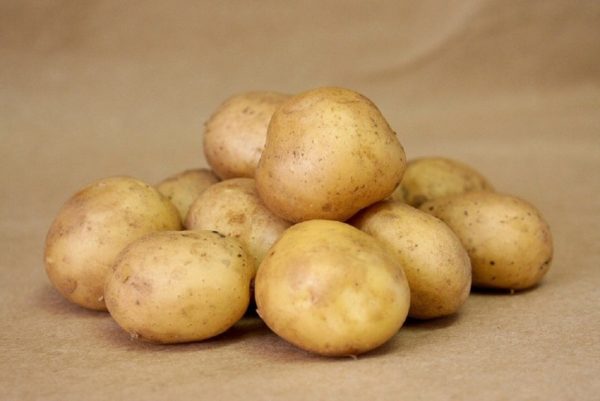
Nowadays, vegetable crops bred in distant European countries are more and more appreciated. This also applies to potatoes. But, few people know that Vector potatoes in their characteristics and taste are in no way inferior to foreign varieties. This potato is relatively unpretentious and easy to grow. With this, Vector potatoes have earned the sympathy of many garden lovers. Let's take a closer look at this variety in our article.
History and characteristics
Vector is a medium-ripening Russian table potato variety (Solanum tuberosum). Received by specialists of the A. G. Lorkh All-Russian Research Institute of Potato Farming. During the breeding, the Zarevo variety and the 1977-76 numbered hybrid were used. In 2014, it was included in the state register of breeding achievements of the Russian Federation.
Approved for cultivation in the Central region of the country (Bryansk, Tula, Smolensk, Vladimir, Kaluga, Ivanovo, Moscow, Ryazan regions). Differs in high resistance to late blight, good yield of marketable products. Suitable for processing into chips. It’s worth making a small reservation right away.
There is a variety of Belarusian selection with a similar name - Vektar, or Vektar Belarusian. It is popularly called "Vector" by the people. In the context of this article, we will focus on Russian breeding potatoes.
The period from the moment of emergence of full shoots to harvest takes 80-100 days. The plant is low, leaf type, semi-erect stems. Leaves are small, intermediate type, dark green in color. The flowers are large, purple. In one nest of the Vector, an average of 8-13 tubers develop, each weighing 92-143 grams, the amount of fines is very insignificant.
The tubers are oval-rounded. The peel is quite strong and red in color. The flesh on the cut is light yellow in color, has a very dense structure. The eyes are small, shallow. The marketable yield of the variety, according to the results of state tests, is 180-263 c / ha, which is comparable to the standards of Bonnie and Kolobok.
The maximum amount was obtained in the Tula region - 403 centners of potatoes were harvested per hectare of planting area, 195 centners / ha more than Aurora. According to some reports, the potential yield can reach 700 c / ha. Marketability is at a very high level - 90-98%, keeping quality is also good - 95%. Vector's taste is excellent.
It belongs to culinary type B, that is, to varieties with an average digestibility of tubers. In cooking, our hero is versatile, suitable for preparing a wide variety of dishes, especially good baked, boiled, fried, and will also be an excellent addition to soups, vegetable mixtures and salads.
When sliced and cooked, the pulp does not lose its attractive color, so the finished dish looks very appetizing. Potatoes have a high starch content in the pulp - 16.7-17.5%. In this regard, our hero is perfect for the industrial production of chips and other processed products: flour, starch, dry puree.
It is also suitable for cooking French fries, both in "kitchen" conditions for personal consumption, and in industrial complexes for sale to retail chains.The variety is moderately demanding on soil fertility and climate. It is best adapted to the conditions of the Central region, however, in other areas it shows good results with proper care.
The vector is drought-resistant, which makes it suitable for cultivation in southern regions with hot summers. Plants are unpretentious in care, but they respond well to various agricultural techniques, including watering and feeding, loosening the soil, weeding, hilling, as well as preventive measures to combat pests and diseases.
One nuance should be noted related to the purchase of seed. As mentioned at the beginning, our hero is often confused with the Belarusian Vektar, and many gardeners themselves do not fully understand which of these two grows on their site. Outwardly, they are very similar, but they differ in terms of ripening - Russian is mid-season, and Belarusian is medium-late.
Be careful when buying seed! Potatoes are resistant to leaf-rolling virus, banded and wrinkled mosaics, and the causative agent of cancer. Susceptible to golden cyst nematode.
According to the originator, it is highly resistant to late blight both in tops and tubers. The vector has proven itself well both in small garden plots and in industrial areas of large agricultural enterprises.
It is especially appreciated for its very high yield, excellent marketability, excellent taste and a large amount of starch in the pulp, as well as for unpretentious care. It is worth noting the resistance of tubers to mechanical damage, making them suitable for machine harvesting. The advantages include drought resistance and, of course, invulnerability to late blight.
Currently, resistance to this "scourge" of potatoes is very important, especially for those gardeners who do not have the opportunity to often visit their site and carry out preventive treatments in time, as well as observe crop rotation. Among the disadvantages is susceptibility to aureus cyst nematode.
Also, the disadvantages can be attributed to the exactingness of soil fertility, but the high yield justifies this. Vector is a rather "young" variety, the potential of which has not yet been fully disclosed, but it is safe to say that in terms of its characteristics it is not inferior to many other time-tested varieties.
Pros and cons of Vector
Potatoes have a number of positives. Among the main ones it should be noted:
- High productivity.
- Good immunity.
- Not afraid of prolonged droughts.
- Excellent taste.
- Good indicators of transportability.
- Excellent keeping quality.
The variety also has its drawbacks. In particular:
- It contains a lot of starch. On the one hand, this is a virtue for those who like boiled potatoes. On the other hand, there is a drawback, since the Vector potatoes are not universal and not suitable for preparing different dishes.
- Late ripening period.
Potatoes "Vector" - variety description, photos, reviews and advantages
The description of the Vector potato variety is similar to other varieties of this crop, but many farmers fell in love with this species because of its merits. These include:
- good taste;
- high productivity;
- unpretentiousness to growing conditions;
- quick adaptability to environmental conditions;
- storage duration;
- rapid emergence of the crop in the first half of the growing season.
Another advantage of the variety is its resistance to common diseases of nightshade crops. Such diseases include: potato nematode, ditylenkhoz, alternaria, late blight. It also does not respond to viruses that infect roots and tubers.
It is also important that this variety is ideal for industrial processing.Chips are made from it, starch and alcohol are produced, and also used as feed for livestock and poultry. There were no drawbacks in the general characteristics of the Vector potato variety.
Usually, in reviews under the descriptions of the Vector potato variety, its advantages are described, less often - some disadvantages. According to experienced gardeners, the Vector potato has 3 main disadvantages. Firstly, when boiling, the potatoes are very boiled, which interferes with the preparation of some dishes.
However, "Vector" is still well suited for cooking, since during cooking it does not lose its golden hue of pulp. Secondly, in reviews of the "Vector" potato variety, its characteristic is often mentioned as late ripening. The last and main disadvantage is the high starch content, which makes up 17 to 19% of the total mass of potatoes.
- Biv: Vector. Good as always. Season opening - Manifesto. Last year he did not show himself as anything remarkable, this year it was a bomb.
- Mikhail: We grew up this year and Vector and Zhuravinka. The vector is earlier and gave a significantly higher yield of large tubers, although it was not bad for Zhuravinka. Yellow flesh, good taste in potatoes, except that it boils a little more than we would like. Perhaps there will be problems with keeping quality and waking up early, but so far we are happy with them. In addition to the good harvest, the pleasant smell of its flowers in summer was a bonus.
- Adele: This variety has been cultivated for a long time. I can say that it grows in absolutely any soil, except for clay. But in those soils that are described above, the greatest yield is obtained. Watering is also not necessary. In hot weather, I water every evening, not flooding, but simply wetting the ground. If the weather is not very hot, then water it every 3-5 days. The main thing is that the earth does not crack.
- Andrey: Last year I tried this variety. The neighbors said that it was necessary to plant small tubers. I listened and, as it turned out, in vain. It was clear from the bush itself that there would be no normal harvest. Tastes good though. Children especially love the French fries made from this variety. And it is ideal for mashed potatoes, because it falls apart during cooking.
- Georgy Piskun: Tubers of the early variety Lileya, middle late Vector, Ragneda are slightly affected by late blight. Tubers of the Vector variety are well kept. Potatoes Vector is quite unpretentious and will endure even the sultry heat. With excellent characteristics and excellent taste, it will become a welcome root crop in any garden!
- Edward So far, only planted a year, the result is normal, but there is no particular enthusiasm either. I'll try to grow it for a couple of years.
Advantages and disadvantages of the variety
This young the potato variety attracts ordinary gardeners and professional farmers with its qualities:
- resistance to most potato diseases;
- unpretentiousness to soil and climate, resistance to frost and drought;
- high yield;
- excellent taste;
- high starch content;
- keeping quality up to 97%;
- the ability to maintain a presentation during transportation.
Of the shortcomings:
- does not belong to varieties universal for culinary use - it crumbles during cooking due to the high starch content;
- ripens for a long time.
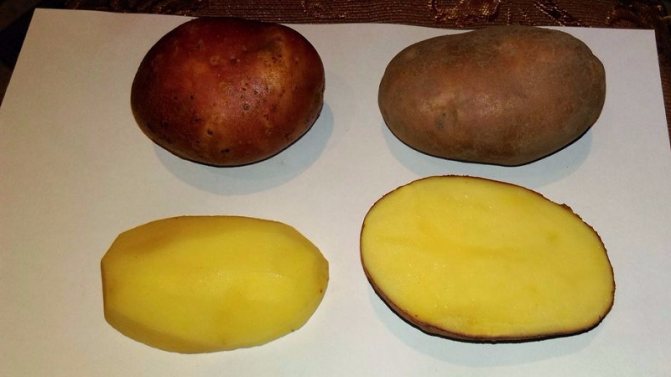

Which regions is best suited for
Most The following regions are considered favorable for growing Vector:
- Central;
- Volgo-Vyatsky;
- Central Black Earth regions.
The variety is successfully cultivated in the Urals, Siberia and even in the north of Russia.
Landing rules
How you plant the Vector potato variety will play a big role in fertility and crop quality. It is important to choose the right tubers for planting. It is necessary to understand that a gorgeous bush will never grow from a small potato. Therefore, for sowing, take tubers, the size of which is not less than a chicken egg.
Sowing potatoes should also have a smooth surface and a large number of eyes.
Before planting potatoes, it is necessary to check for infections and diseases. After you have selected the suitable tubers, they must be distributed in the boxes in an even layer and wait for the shoots to appear. You can speed up this process by adding sawdust to the box and sprinkling it with a little water.
When the potatoes are germinated, take them out in the sun a few days before planting to warm them up. It is necessary to choose and prepare a place for planting potatoes in advance. As mentioned earlier, the Vector is relatively not picky about the soils for planting, but if there is a choice, then it should be made in favor of slightly acidic and neutral lands.
You can fertilize the soil for planting 2 times: the first time during the autumn digging (it can be omitted), the second just before planting. On the day you plan to plant potatoes, dig small shovel-sized holes 50 cm apart. Fertilizer based on excess manure and wood ash should be added to these holes.
Do not be afraid to overdo it with fertilizer - the Vector will not react to a small increase in the dose of fertilizing. Place the potatoes on top of fertilizer sprouts and carefully cover them with earth. Try not to damage the sprouts! Finally, level the ground with a rake.
ogorod-bez-
Testimonials
Ekaterina Yurievna, Voronezh, 56 years old.
This is probably one of the most stable varieties that I have come across. The vector does not require any serious effort to grow. By myself, I'm a lazy person, I don't like to poke around in the garden, but even I manage to "squeeze" a good harvest out of the Vector. I do one hilling per season, sometimes we pickle from Colorado beetles, since we have a darkness of them. I water it only 2 times per season, and then not systematically, when it is very hot. The taste is excellent, it is most suitable for making mashed potatoes, as it is very soft.
Ivan Konstantinovich.
I grow a variety in the field, for sale. The yield is high, and the marketable yield is also excellent. There are zero problems with parasites, I learned to deal with them even before they appeared. Transporting the Vector is easy, the tubers are not damaged during long-term transportation. I have been growing for more than 5 years, so I can give an estimate. They buy up quickly on the market.
Elena Viktorovna.
I have been growing it for more than one year. During this time, I can fully characterize the variety. First, it grows even if the soil is not particularly fertilized. Secondly, it does not really need watering. I do 2-3 watering, depending on the possibility (we live in the city, potatoes grow in the country), and from the heat. The taste is excellent, you can fry, cook and make soup.
Seed picking
The choice of tubers for sowing must be approached with all responsibility. Here, the yield depends directly on the size, quality and health of the sowing material. Many people think that a gorgeous bush with large potatoes will grow from small potatoes. It's a delusion. So, the tubers for sowing should be:
- the size of a chicken egg;
- even;
- with the absence of any signs of diseases and pests;
- with a lot of eyes;
If the seeds purchased at breeding fairs or homemade seeds have already sprouted, in no case should they break off and damage them - this will negatively affect the seedlings!
Seed tubers should be of medium size, healthy, without mechanical damage.
The only exception to the size of seed tubers can only be if the potatoes are purchased for further breeding and will not be used for eating in the first year. These are usually little-known Dutch varieties.
How to harvest and store crops
Potatoes are harvested in sunny weather, dried well, cleaned from the ground, sorted, put in boxes prepared in advance. Only healthy, undamaged tubers are selected for storage.
Frozen, injured, rotting tubers cannot be stored.Their safety will have a negative impact on quality root crops stored in storage.
Note! This type of nightshade can be kept in storage separately from other vegetables, or together with beets. Beets placed on top of the tubers will prevent potatoes from rotting. It will absorb excess moisture in the room.
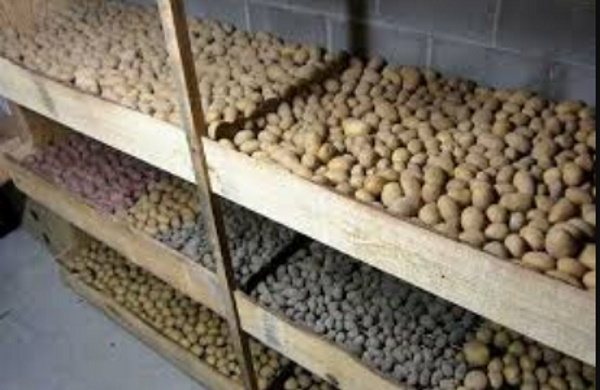

It is better to store the crop in boxes.
Variety Vector has good keeping quality. If the storage room maintains a certain temperature and humidity, it is equipped with ventilation, then the harvest can easily be stored until spring, until the new harvest. Thus, on the table there will always be dishes with delicious boiled potatoes.
Seed preparation
Before planting, the potatoes need to be prepared so that the shoots are quick. Selected seeds are laid out in boxes or on another flat dry surface in one row. After a while, sprouts will appear. You can pour sawdust into boxes with tubers and water with cold water - this is also a fairly effective way of germinating potatoes.
A few days before planting, the seeds need to be warmed up. To do this, you need to take them out in the sun, spreading them on a dry surface; can be left in boxes.
maja-
Harvesting
Vector potatoes ripen approximately 100-110 days after planting. The tubers weigh 90–140 g. The variety has good transportability and resistance to mechanical damage.
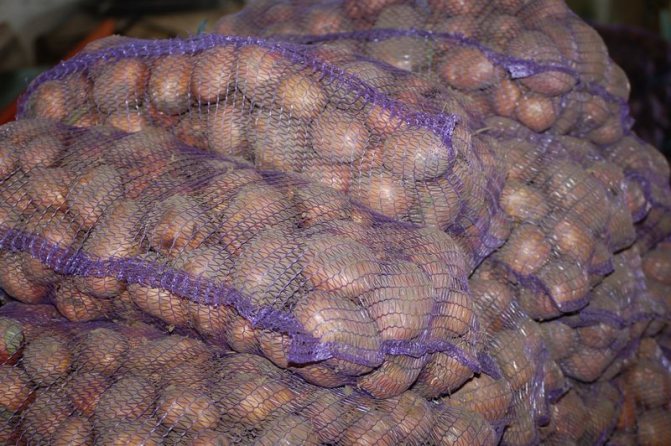

Vector potato harvest begins 100 days after planting
Storage rules
The vector is distinguished by good keeping quality. But some procedures before storage are still worth doing:
- after digging, the tubers need to be dried by spreading them on a dry flat surface;
- fold potatoes carefully, avoiding damage;
- sort out tubers, destroy sick ones.
Seat selection
The vector is unpretentious and grows on any soil. But on loams the yield will be slightly higher. You shouldn't forget about acidity either - slightly acidic and neutral soils are ideal for potatoes (pH 4.5–5.5).
The soil for planting tubers is prepared in advance. For the autumn digging of the soil, a number of fertilizers are applied at the rate of 1 m²:
- 15 g double superphosphate;
- 12 g of potassium sulfate;
- 10 g of urea.
Immediately before planting, fertilizer is applied to each hole. This is the so-called pit feeding method. It is considered one of the most effective, because the maximum amount of nutrients gets to the destination. This will require:
- 500 g of rotted manure (not fresh!);
- 100 g of wood ash;
- 10 g of urea.
There is no need to be afraid of excess fertilization: potatoes will not react negatively to this. But you should be careful with organic fertilizers.
maja-
Signs of disease
Late blight can be recognized by certain signs. Dark spots form on the leaves, which spread to the stem. The plant dries up soon after. A symptom of Alternaria is dark, merging spots.
You can find out that the culture was affected by scab only after removing the tubers. Immediately after digging up, a cobweb plaque will be visible on them. Then it disappears and an ulcer can be found on the root crops.
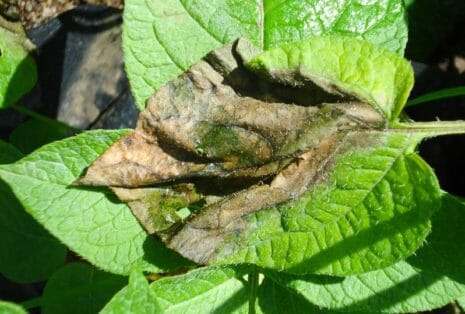

Care features
Despite the fact that the Vector potato variety is unpretentious to growing conditions, it is necessary to adhere to some rules for caring for this variety in order to get a high-quality harvest. You need to start caring for the plant from the moment of planting.
It is important that the tubers are provided with air. To do this, you need to periodically loosen the ground and remove weeds.
For the first time after planting, a rake can be used to loosen the soil. But after the sprouts appear, the beds should be loosened after moistening the soil. Do not allow the top layer of the earth to harden.Other important aspects of crop care are watering, weeding, fertilizing the soil, treating insects and preventing disease.
How to grow this variety
Vector is easy to grow, observing the simple rules of agricultural technology described below.
Timing, scheme and landing rules
Depending on the region of cultivation, Vector is planted in April - May, in the northern regions - in late May or early June. By the time of landing, they monitor that the ground temperature warms up to + 10 ° C.
Interesting! Experienced summer residents determine the timing of planting potatoes by the size of a birch leaf. If it has reached the size of a five-kopeck coin, it means that the earth has warmed up to the temperature required for planting potatoes.
2-3 weeks before disembarkation taken out of storage and taken out to a lighted warm place. During this time, the tubers will sprout, turn green and be ready for planting.
For planting material, choose healthy (no flaws) tubers medium and large in size, on which there are at least three shoots. The more there are, the more vigorously the plant develops. In no case should you pick off the sprouts from the tuber. This is the most necessary component of the planting material.
The variety is sensitive to planting densitytherefore it is important to follow a clear pattern. The distance between the rows is at least 70 cm, between the tubers - 40-50 cm. Such a placement plan promotes better air penetration into the soil and the convenience of hilling.
There are two options for planting potatoes:
- The traditional method consists in digging holes to a depth of 5 cm, placing the planting material in them and sprinkling it with earth.
- If the soil is dense, then 10 cm high ridges are cut with a cultivator and the tuber is immersed into the ridge to a depth of 6-10 cm.
These two options suitable for gardeners who grow potatoes in small quantities for personal consumption.
Farmers are planting potatoes in a mechanized way. High ridges, which are obtained with the help of motor vehicles, warm up faster, there is no excess moisture in them, and the earth is saturated with air. In such conditions, the root system is developing intensively.
Care
Vector is unpretentious to soil composition... But light and fertilized soil suits him best. For this, 3 kg of humus and 100 g of wood ash are introduced for each 1 m². The most suitable are loamy and sandy soils, as well as black soil.
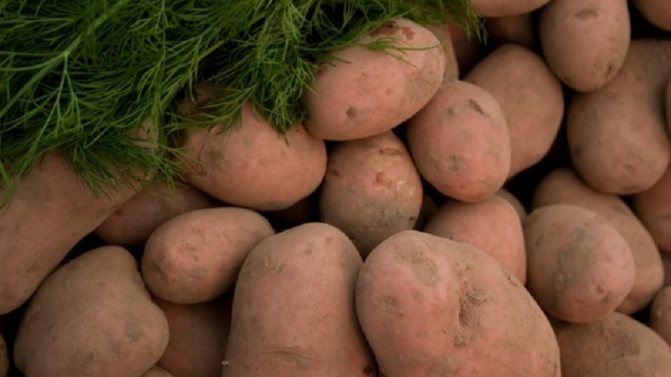

Potatoes responsive to watering in the bud and flowering stage... It is watered 4-5 times per season. If it is a rainy summer, the frequency of watering is reduced.
Important! Do not allow stagnation of water in the soil. Otherwise, the formed young tubers will begin to rot. But drying out of the earth will negatively affect the development of the plant.
Weed control is an essential part of potato care... In order for the nutrients to get to the crop, weeds are removed as they appear.
Hilling is carried out 2-3 times per season:
- When the plants reach a height of 20-25 cm, the seedlings are almost completely covered with soil. During this procedure, the soil is saturated with oxygen, the plant is protected from possible frost and the tubers will not be outside as it grows.
- Re-hilling is carried out 2-3 weeks after the first.
- If the height of the potato tops allows and the rows have not closed, they huddle the third time (about a month after the second hilling).
The nuances of growing and possible difficulties, diseases and pests
There are no special agrotechnical methods for growing Vector.... The key to success is healthy planting material, timely planting and watering, weeding and hilling.
Difficulties arise with plant diseases and the appearance of pests. In rare cases, the Vector is susceptible to:
- Wrinkled mosaic - a viral disease that is transmitted by aphids, Colorado potato beetle, bedbugs. The disease occurs more often in hot and arid climates. It is manifested by twisting and changing the color of the leaves. This stops the growth of the plant and reduces the yield.To prevent the disease from spreading en masse, diseased bushes are removed.
- Striped mosaic is a viral disease that occurs when planting infected tubers or using dirty tools. Do not neglect preventive measures: carefully inspect the planting material, use treated equipment.
For scab, potato crayfish, late blight, Alternaria, the variety has stable immunity.
Watering
Until buds begin to form on the bushes, the plant does not need to be watered. But after their appearance, the potatoes need constant moisture. It is important to know that this culture cannot be constantly flooded with water. It is only necessary to moisten the ground when it dries out to about 7 cm.
The best time to water is in the evening. Each bush needs 2.5 liters of water. In the summer, during the hot period, the potatoes need to be watered on average 4 times during the growing season. After this procedure, it is recommended to loosen the soil.
Fertilizers for potatoes
Fertilizers are applied during the spring digging of the site, evenly distributing them over the entire area. For 100 square meters they give 500-600 kilograms of manure, humus, peat or compost, 15-20 kilograms of bird droppings, 15-20 kilograms of ash, and mineral fertilizers - 2-3 kilograms of ammonium nitrate, 3-5 kilograms of superphosphate and 1.5 —2.5 kilograms of potassium salt.
This amount of mineral fertilizers can be replaced by 8-10 kilograms of their finished mixture ("vegetable mixture").
With the combined application of organic and mineral fertilizers, the greatest increase in yield is obtained. In this case, the doses of both those and others are reduced by half.
A great effect is provided by the introduction of 50 kilograms of manure, 2 kilograms of super-phosphate and 5 kilograms of lime per 100 square meters. Manure is mixed with lime in advance, and superphosphate is added to them a day before using this fertilizer mixture.
Experiments show that a 1.5-fold increase in the dose of phosphorus fertilizers in the total mass of fertilizers applied for potatoes significantly increases the yield of tubers and their starchiness.
If there is a lack of fertilizers, you can apply them to the holes or furrows. In this case, fertilizers are spent 2 times less, and the yield increase is the same as with continuous filling of the soil. A potato bush requires 150-200 grams of humus.
They put it at the bottom of the hole, and the tubers are planted in its side. A vegetable mixture of mineral fertilizers is sufficient 3-5 grams per well. It is mixed with earth or used as an aqueous solution. Wood ash, introduced when planting potatoes, improves its taste and increases the starchiness of the tubers. One or two handfuls of wood ash are placed in each hole and mixed with the ground.
Peat ash is a valuable fertilizer for potatoes. It has been established by experience and practice that peat ash is not inferior to wood ash in its effect on potato yield, and surpasses it in its effect on starchiness. The only drawback of peat ash is that it should be applied in 30-40 kilograms.
For 100 square meters instead of 7-10 kilograms of wood ash. With the local method of application, that is, in a furrow or nest, the dose of peat ash can be reduced 3-4 times.
Mineral fertilizers or ash are poured into the hole with a layer of earth 2-3 centimeters, then the tuber is planted, covered with earth and the area is leveled with a rake.
Top dressing of potatoes
Fertilizing plants with organic or mineral fertilizers is one of the most important methods of caring for potatoes. It is carried out before loosening and hilling. Apply dry and liquid top dressing. The first time feeding is applied at a height of potato plants of 10-15 centimeters, the second time - 15-20 days after the first feeding.
With dry top dressing, one or two handfuls of wood ash, previously mixed with earth, or 15 grams of well-crushed bird droppings, are consumed for each potato bush. A vegetable mixture of mineral fertilizers is enough for one tablespoon per bush.
If nitrogen fertilizer, superphosphate and potassium salt are used for feeding separately, then each of them is taken one teaspoon. Under each potato bush, 1-1.5 liters of fertilizer solution is applied.
Dry top dressing is sealed in the aisles at a distance of 8-10 centimeters from the plants, and with liquid top dressing around each bush or along the rows on both sides of the bushes, shallow grooves are made with a hoe, into which a fertilizer solution is poured. As soon as the liquid is absorbed into the soil, the groove is sprinkled with humus, peat, earth, or loosening, hilling is carried out.
Both dry and liquid top dressing should be applied to wet soil after rain or watering. Fed plants also need to be watered.
Diseases and pests
The characteristic of Vector potatoes says that this variety is resistant to many diseases. This is true, however, there are some diseases that can affect even this resistant variety.
- Late blight of leaves. A common disease that can overcome almost all types of potatoes. It is a fungal disease. To avoid the appearance of late blight, first of all, it is necessary to get rid of weeds in the beds in time, and also for prevention, spray the plants with a solution of vitriol every 10 days. The medicine Fungicide Ridomil will help get rid of this disease. It is worth using it, relying on the instructions.
- Dry spotting. It is expressed on the leaves in black spots several weeks before flowering. Alternaria, as this disease is called in another way, affects all parts of the potato. It arises solely from the sowing of infected tubers. Therefore, it is so important to choose the right material for sowing correctly. If you missed this moment, and the potatoes got sick with altarnaria, then for treatment during the growing season, spray the potatoes with a solution of Profit or Utan.
- Scab. Scab-infested tubers are covered with ulcers that merge into one spot. This disease also appears due to inattentive examination of tubers before planting. To prevent common scab, spray the tubers with Trichodermin before sowing. If ulcers appear on the potato tubers, it is no longer possible to cure them.
In addition to diseases, the Vector potato can also be overcome by some insects. Among them:
- Colorado beetle. The orange larvae of this insect are especially dangerous. They are gluttonous and can chew on all the leaves of a potato. To prevent this from happening, it is necessary to remove adult Colorado beetles from the potatoes in a timely manner, before they have time to lay the larvae on the underside of the leaves. The adult Colorado potato beetle has white stripes along its back, so it can be easily distinguished from other insects. To get rid of these bugs, you can pick them by hand or use Karado's insecticide.
- Medvedka. A large underground insect (up to 5 cm in length) breaks through underground passages and damages potato tubers. To eliminate these insects while loosening the soil, you can add small pieces of eggshells to the soil, on which the bears can easily get hurt. And also to get rid of the annoying pest around the perimeter of the beds, you can plant chrysanthemums. The problem can be solved with the help of Rembeck and Vofatox chemicals.
- Slug. An ardent pest of vegetable crops, eating the leaves and fruits of potatoes. It has a brown color and a reduced shell. The main activity behind this insect is noticed at night. To get rid of slugs in the garden, you can break the eggshells and scatter them throughout the garden.The body of the slugs is vulnerable, so if the insect crawls over a sharp shell, then it will clearly suffer and is unlikely to damage the potatoes. And you can also put boards or roofing material on the ground - these are favorable places for the accumulation of slugs, and then manually collect pests from there.
If there are a lot of slugs in the garden, then collecting them by hand is useless. In this case, use the chemical Pochin.
And the last, but no less dangerous pest of vegetable gardens is the wireworm beetle. Its name fully corresponds to its appearance: its body is up to 2 cm long and its orange coloration with a black head makes the insect look like a piece of wire. Trapping these pests is easy enough. To do this, prick pieces of potatoes onto toothpicks and bury them 15 cm in the ground.
After 5 days, remove the potatoes with a toothpick and remove the wireworm larvae from the trap. To avoid the appearance of these insects, it is necessary to spray the wells with a solution of potassium permanganate during planting potatoes. If the above methods do not help, use the drug Bazudin.
ogorod-bez-
The nuances of plant care
Caring for Vector potatoes is easy. Standard care involves timely watering, applying fertilizers, hilling the beds, loosening and mulching the soil. You should also treat bushes from diseases, harmful beetles.
Watering and feeding the "Vector" variety
To get a decent harvest, 4-5 waterings are required during the growing season. The first irrigation is done after the formation of tops, when it rises 15 cm above the surface. Water is added the second time after the formation of flowers. The third watering occurs after flowering. For the last time, add a little water, half a bucket per bush. Otherwise, the risk of late blight increases.
Fertilizers are added in several passes. First time after landing. In 10 liters of water, 1 liter of chicken manure, or 1 tablespoon of urea, is diluted. Water 0.5 liters under each bush. The procedure is carried out after loosening the soil.
See also
Reasons why potatoes do not bloom, and what needs to be done to have a good harvest
To read
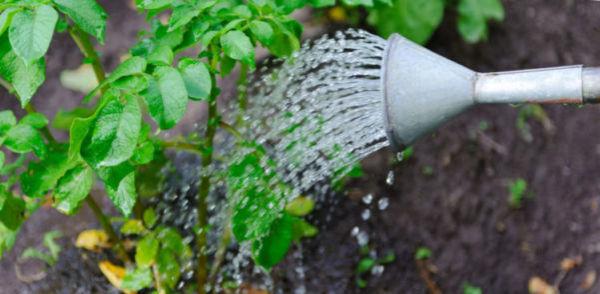

If the culture is poorly developed, the leaves are small, fertilize it in 3 stages.
- Before flowering, add 1 tablespoon of potassium sulfate to 10 liters of water.
- During budding, 1 tablespoon
- During flowering, 1 tablespoon double superphosphate in 10 liters of water.
Each bush requires half a bucket of feed. You can still scatter urea over a dessert spoon under the potatoes.
Loosening and mulching of the soil
The soil is loosened before and after planting. When the first shoots appear, weeding is carried out 5 cm deep. A procedure is also needed, when the plants begin to grow rapidly, a lot of weeds arise. The soil is additionally loosened when the soil is stagnant, after a rainstorm.
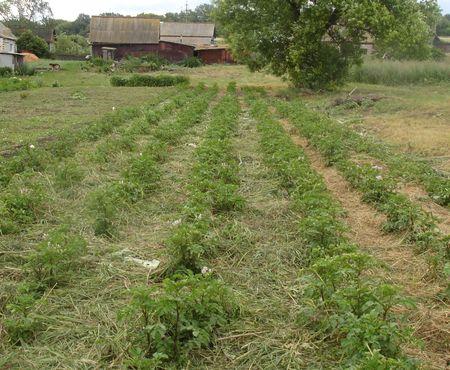

Hilling potato beds
Potatoes are spud 2 times during the growing season.
- The first time, after the tops have gained 20 cm in height.
- The second hilling is done as the tops grow. Usually 21 days after the first procedure.
Due to hilling, the tops do not bend to the soil, weeds are removed. Manipulation swells the soil, it is saturated with oxygen.
What pathologies and beetles are dangerous for potatoes "Vector"
Potato Vector is famous for its resistance to late blight, viruses, scab, alternaria, and cancer. Sometimes the bushes are exposed to banded and wrinkled mosaics, leaf twisting. Among the harmful beetles, the golden cyst nematode attacks. Preventive treatment will help prevent these problems. It is carried out in this way:
- carefully select seeds before sowing;
- observe planting schemes so that the plants do not thicken;
- spray the bushes from fungal infections with special preparations;
- observe crop rotation.
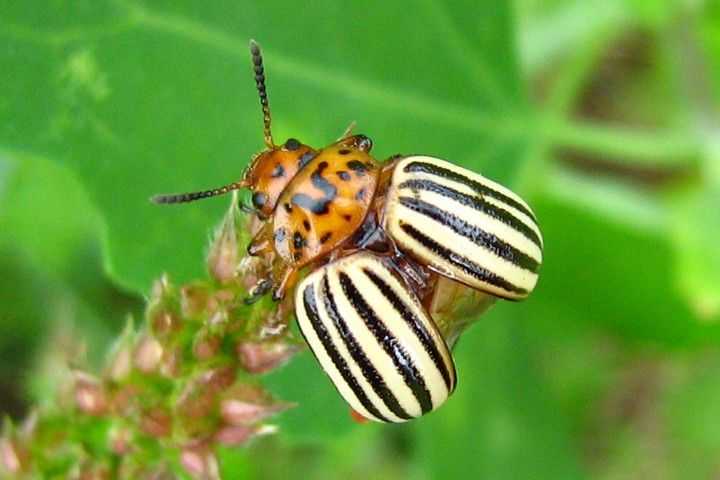

The Colorado potato beetle often attacks potatoes of any kind, they get rid of it with the help of insecticides, picking it by hand.Wireworms, slugs, bears are capable of causing more harm. They are taken out by placing traps, baiting with insecticides.

